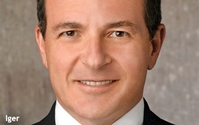
Against the
backdrop of Walt Disney posting a strong financial second quarter, top company executives believe the TV upfront malaise could right itself in the scatter period.
Bob Iger, chairman/CEO of Walt
Disney, told analysts in an earnings call: “Some of the money just wasn’t expressed because advertisers are choosing to essentially commit the spending much closer to the time that the
spots actually run. You’re going to see some of the money that wasn’t in the upfront expressed in scatter and some of it clearly move to new platforms.”
With broadcast
networks dropping around 7% in volume for this year’s upfront market and cable networks losing around 5%, according to estimates, many believe that money may have moved to digital
advertising.
But Iger said: “I don’t think all the money that’s flowed away from broadcasting in the upfront necessarily flowed directly into new digital platforms, even
though I believe that these platforms have siphoned off some money from the traditional broadcasters.”
advertisement
advertisement
Good news for Walt Disney’s powerful ESPN -- it bucked this overall trend,
with higher upfront volume. Iger says: “It happened late so it basically just ended, but there the numbers were very compelling in that you had absolute increased volume of spending over
last year. So not just increased rates or increased units sold but increased dollars committed to ESPN in the upfront.”
Iger believes the draw of the immediacy of sports programming has
brought new advertisers to the network -- as well as seeing existing advertisers raise budgets on ESPN.
ESPN witnessed 10% growth in second-quarter advertising revenues, largely due to the
World Cup. But without the World Cup, ESPN was still 5% higher. Jay Rasulo, senior executive vice president/CFO of Disney, says ESPN continues to pace higher in the third quarter.
For its
fiscal third quarter, Walt Disney posted a 8% gain in revenues to $12.5 billion. Net income was 22% higher to $2.2 billion.